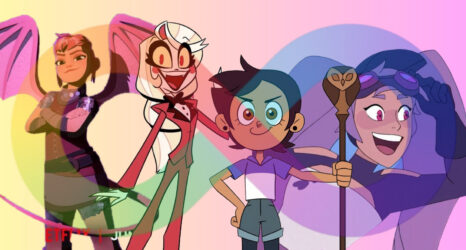UPDATE: The L.A. Times reports that, according to a Disney representative, the company has no intention of abandoning its “sexier” new depiction of Merida, which will illustrate a limited run of products, including backpacks and pajamas. The rep said that the previous version of Merida would still be available on other Disney products.
Bravery comes in all shapes and sizes. Wait, scratch that: Bravery comes in a size 2.
Disney fans have been up in arms this week over Princess Merida’s sexy makeover. After her official induction into the elite princess clique, Merida, the hero of the animated feature Brave, appeared on Disney’s website with a whole new look—a look, many feel, that contradicts Merida’s entire character.
In her new design, Merida, who would probably roll her eyes at the prospect of a princess coronation, is minus a few pounds, her trademark bow and her tomboyish charm: “Her eyes are wider, her waist is smaller, her hair is sleeker, and her dress is sparkly as shit.” It’s as if Disney traded her in for a Pirates of the Caribbean wench. Brenda Chapman, the film’s writer and co-director, was outraged about the change.
[Merida is] strong inside and out—she’s not just a simpering pretty face waiting around for romance! She was created to turn that whole ideal on it’s head!
Disney seems to have taken note. As of yesterday, the company silently replaced its website’s controversial new Merida with the original Pixar design. The consideration for fans’ concerns is a relief, but Disney has yet to confirm whether “sexy” Merida is scrapped for good. What made Disney think it could get away with the makeover in the first place?
Merida’s story has been a refreshing change of pace for the Disney Princess franchise. Prior to Merida, with her fiery mane and matching personality, Disney was still churning out tales of heternormative romances for children to adore and absorb. Conventionally beautiful, thin-waisted ladies have been running into the arms of their male counterparts from Snow White (1937) to Rapunzel (2010). There have been exceptions to the standard, hyper-feminine Disney girl who spends most of her screen time flirting—Mulan’s cross-dressing, China-saving badassery comes to mind—but all ten members of the Princess Club, including Mulan, land a boyfriend or husband before the final credits roll. That is, until Merida, a tomboy whose affections are reserved for her beloved bow.
Bravery is not an unfamiliar quality for Disney princesses—most, if not all, of its princesses challenge their comfort zones to explore “a whole new world,” and in this respect Merida’s title trait isn’t exactly mold-shattering. Her single status, however, is: Merida is the first princess to go adventuring sans dude. No Flynn Ryder by her side, no Aladdin or John Smith pushing her to test new waters (or land, if you’re a mermaid).
The young Scottish princess in Brave adamantly rejects her parents’ plans for marriage and decides to “shoot for [her] own hand.” Not only does she rebel against impending coupledom, but she’s clearly a better archer than all of her suitors. Like Mulan, Merida proves that she is just as competent as a man, if not more so. But unlike Mulan, Merida has zero interest in sharing her accomplishments with a (male) partner.
Furthermore, instead of focusing on the relationship between a princess and her prince-to-be, Brave denies any man the spotlight in Merida’s life, instead developing the relationship between two women: Merida and her mother, Queen Elinor. After a long line of hetero-romantic predecessors, Merida’s solo journey to understand herself and her mom can be considered a feminist step away from common female tropes—such as the one that states a woman’s journey isn’t really over until she gets hitched. Quite simply, Merida finally gives us the option of a princeless princess.
So did Disney compromise progress by giving Merida a princess makeover? Mostly, yes. But in some ways, not as much as you’d think.
Merida’s original looks aren’t doing much to add to the diversity of women in film to begin with, and we need to keep this in mind when critiquing female representation.There’s a lot that changes between the two Disney images, but both designs still feature a thin, white, attractive girl who is easily read as feminine—long, flowing hair and all (however unkempt). It’s Merida’s story and personality that define her uniquely independent strides in princess history. Her appearance, on the other hand, hasn’t done much to rock the representation boat. If we really want to expand Disney’s representation, then how about a princess who is fat? Queer? Disabled?
At the same time, though, it’s still important to recognize that the new get-up could only contribute to the trend of sexualizing women in film—animated or not. After all, Merida wasn’t alone in her makeover: Disney recently revamped all its princesses to look sexy-chic, which is a little creepy for characters who are not even 20 years old. But what’s sad about Merida’s new look in particular is that Disney had successfully designed a girl who didn’t conform to the male gaze, and instead of leaving her alone they ended up suggesting that maybe, post-movie, she could have a heternormative fairy-tale ending like all her partnered colleagues if she just bats her thick new lashes hard enough. Disney slipped back into comfortably outdated sexist imagery, then scrapped the design without apology or reflection (so far).
Still, the Merida fiasco provides an example of how interacting with media can change what we see. With female representation in American film at its lowest in five years, we need to be critical of who makes it to the big screen and how they’re depicted. If criticizing sexy Merida can make Disney think twice, maybe we can fend off more harmful tropes in mass-produced films.
Are we one step closer to a fat, queer, disabled princess—or at least a Black princess devoid of racial stereotyping? Maybe. When you wish upon a star…
Image courtesy of Huffington Post





